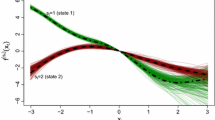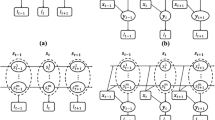Abstract
We provide a framework for modelling habit persistence in choice that integrates vector auto-regressive and moving-average (VARMA) time-series models with random coefficient Multinomial Probit (MNP) models. We provide two classes of models. In the first we assume that the error in the utility function has a general VARMA structure, and in the second we assume that structure for the regression coefficients. We provide an interpretation of these two classes of models. As an illustration, we re-analyse the A.C. Nielsen Company 1986/1987 scanner panel data on ketchup purchases and compare our model with two alternative state dependence models.
Similar content being viewed by others
References
Ailawadi, Kusum L. Karen Gedenk, and Scott A. Nestlin. (1998). ‘Heterogeneity and Purchase Event Feedback and in Choice Models: An Empirical Analysis with Implications for Model Building,’ International Journal of Research in Marketing 16(3), 177–198.
Allenby, Greg M. and Peter J. Lenk. (1994). ‘Modeling Household Purchase Behavior with Logistic Normal Regression,’ Journal of the American Statistical Association 89(428), 1218–1231.
Guadagni, P.M. and John D.C. Little. (1983). ‘A Logit Model of Brand Choice,’ Marketing Science, 2 (Summer), 203–238.
Hajivassiliou, Vassilis A. (1993). ‘Simulation Estimation Methods for Limited Dependent Variable Models.’ In Maddala G.S. Rao C.R. and Vinod H.D. (eds.), Handbook of Statistics, Vol 11.
Hansens, Dominique M. Len J. Parsons, and Randy L.L. Schultz. (1994). Market Response Models: Econometric and Time Series Analysis, Amsterdam: Kluwer.
Heckman, James (1983). ‘Statistical Models for Discrete Panel Data.’ In: Charles Manski and Daniel McFadden (eds.), Structural analysis of Discrete Data with Econometric Applications, Cambridge Mass.: MIT Press, 114–178.
Jones, Morgan J. and Jane T. Landwehr. (1988). ‘Removing heterogeneity Bias from Logit Model Estimation,’ Marketing Science, 7 (Winter), 41–59.
Keane, Michael P. (1997). ‘Modeling Heterogeneity and State Dependence in Consumer Choice Behavior,’ Journal of Business and Economic Statistics 15 (July), 310–327.
McFadden, Daniel. (1989). ‘A Method of Simulated Moments for the Estimation of Discrete Response Models without Numerical Integration,’ Econometrica 57(5), 995–1026.
Papatla, Puroshottam and Lakshman Krishnamurthi. (1996). ‘Measuring the Dynamic Effects of Promotions on Brand Choice,’ Journal of Marketing Research, 33 (February) 20–36.
Schwartz, G. (1978). ‘Estimating the Dimension of the Model,’ Annals of Statistics 6, 461–464.
Author information
Authors and Affiliations
Rights and permissions
About this article
Cite this article
Haaijer, R., Wedel, M. Habit Persistence in Time Series Models of Discrete Choice. Marketing Letters 12, 25–35 (2001). https://doi.org/10.1023/A:1008163801995
Issue Date:
DOI: https://doi.org/10.1023/A:1008163801995




